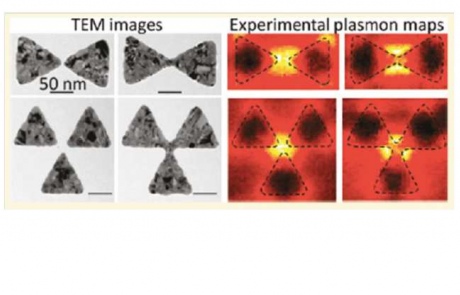
A surface plasmon waveguide, showing where light is coupled in from the outside, in order to propagate along the surface.

When physics and electronics collide, the results can be illuminating - as Imperial's nanoplasmonic group demonstrates.
Understanding light at a fundamental level; capturing it, channelling it at the tiniest scale and using it to perform an array of useful functions – that’s the focus of Imperial’s nanoplasmonic group, based in the Department of Physics; a group that has grown from a single member to a team of 30 in just eight years.
“We’ve been fortunate enough to attract some very high quality people, who’ve quickly been able to come up with their own projects and get funding for them” explains Professor Stefan Maier, head of the nanoplasmonics group. “That’s one of the reason’s we’ve grown so fast. The other is that the field is very interdisciplinary and we have been very successful with our collaborations, both internally and externally.”
Understanding plasmons
We’ve been fortunate enough to attract some very high quality people, who’ve quickly been able to come up with their own projects and get funding for them. That’s one of the reason’s we’ve grown so fast. The other is that the field is very interdisciplinary and we have been very successful with our collaborations
– Professor Stefan Maier
Lee-Lucas Chair of Experimental Physics, Department of Physics
Nanoplasmonics is a relatively new field that marries photonics with nanotechnology.
When light interacts with metallic nanostructures, the light waves couple with the oscillating waves of electrons inside the metal to form a new entity. This has the properties of both waves and is called a localized surface plasmon.
Being able to confine and guide light in the form of surface plasmon waves has exciting potential across a wide range of sectors, including sensing technology, energy, high-density data storage and security. For example, they could be the key to ultra-fast information processing devices or to super-sensitive chemical detectors ideal for airport security.
“The field can influence so many things”, says Professor Maier: “What’s really exciting us at the moment is the potential to influence chemical reactions, something which could improve energy efficiency and also lead to new methods of biological and medical imaging.”
Leading the world
Nanoplasmonics is a highly interdisciplinary field and Professor Maier is keen to promote collaboration within his group, across Imperial and further afield:
“Together with colleagues at King’s College London, we are leading the field internationally”, he says, crediting Imperial’s “interdisciplinary spirit, high quality people and supportive environment” as the bedrock of this growing success.

This picture shows how well the light is localized to these small antennas.
Recognition is also growing. In 2010, Professor Maier’s pioneering nanoplasmonics work was awarded two distinguished prizes - the international Sackler Prize in the Physics Sciences, awarded by Tel Aviv University, and the Paterson Medal of the Institute of Physics. And more recently, he was named Lee-Lucas Chair of Experimental Physics, in succession of Professor Donal Bradley FRS OBE.
Your role in this success
Nanoplasmonics is another example of how science and technology have the power to transform the world. The complex challenges of today demand such innovation and Imperial is particularly good at it – thanks to the continued support of alumni and friends.
If you would like to help, please visit the giving pages of our website to see how your gift could make a difference.
Article text (excluding photos or graphics) available under an Attribution-NonCommercial-ShareAlike Creative Commons license.
Photos and graphics subject to third party copyright used with permission or © Imperial College London.
Reporters
Jenn Rowater
Advancement

Contact details
Tel: +44 (0)20 7594 6697
Email: j.rowater@imperial.ac.uk
Show all stories by this author
Imogen Ashfield
Advancement

Contact details
Email: press.office@imperial.ac.uk
Show all stories by this author



